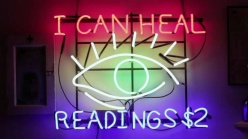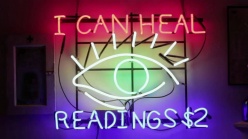RAGGA NYC will be in residence through the Department of Education and Public Engagement’s R&D Season: BODY.
Tau Lewis, Georgia marble marks slave burial sites across America, 2016. Plaster, cement, acrylic paint, chain, and high-gloss finish, 18 1/2 × 12 1/2 × 8 1/2 in (47 × 31.8 × 21.6 cm). Collection Christine and Murray Quinn. Courtesy Cooper Cole and the artist
Fifth Floor Visit Us
Interested in learning more? Download the audio guide
RAGGA NYC is in residence through the Department of Education and Public Engagement’s R&D Season: BODY. A platform founded by Christopher Udemezue, RAGGA connects a community of queer Caribbean artists working across a wide range of disciplines—including visual art, fashion, and poetry—to explore how race, sexuality, gender, heritage, and history inform their work and their lives. A vibrant community deeply committed to education and grassroots organizing, RAGGA fosters a network and an extended family that makes space for solidarity, celebration, and expression. Their residency explores Afro-Caribbean diasporic traditions, bringing together works by a group of artists who trace their own relationships to Caribbean history. The exhibition includes sculptures from Renée Stout’s Roots and Charms series, which nod to the hand-painted signs advertising elixirs and spiritual healing on the storefronts of shops in New Orleans and Washington D.C., and to the symbolic objects found within them. Tau Lewis’s foraged, ain’t free series portrays cacti, plants transplanted to radically different climates where they thrive nevertheless, a metaphor for the diasporic condition. Works in Paul Anthony Smith’s Grey Area series layer grainy silkscreened images of male acquaintances Smith encountered while back in his hometown in Jamaica for his aunt’s funeral, alongside images of a cemetery burial ground, suggesting a complex relationship to an island he left as a child.
Taking up Édouard Glissant’s claim that “the language of the Caribbean artist does not originate in the obsession with celebrating his inner self; this inner self is inseparable from the future evolution of his community [in which] he is his own ethnologist, historian, [and] linguist,” RAGGA NYC’s residency also features a number of public programs, including workshops exploring Afro-Caribbean spiritual traditions and an evening of performances and poetry by members of RAGGA.
This exhibition is curated by Sara O’Keeffe, Assistant Curator.






